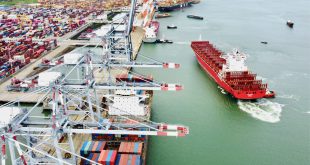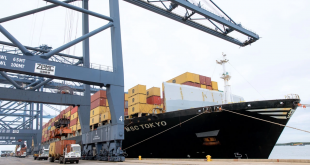Since August, Vietnam’s export sector has started to feel the devastating effects of the pandemic and strict social distancing measures in many localities nationwide plus the disruption of supply chains and production.
According to a report by the Ministry of Industry and Trade (MIT), Vietnam’s export sales in August 2021 were estimated at US$26.2 billion, a decline of 6% from July. Of this, the domestic sector gained US$6.94 billion, down by 9.7% from the previous month, while the foreign investment sector—including crude oil—reached US$19.26 billion, down by 4.5%.
Compared with the same period of last year, August export value fell by 5.4%, of which the domestic sector saw a drop of 13.9% and the foreign investment sector, including crude oil, suffered a slight decline of 1.9%.
During the Jan. – Aug. period, goods export sales reached US$212.55 billion, a rise of 21.2% year on year.
Also in August, the annualized revenues of the three key export groups all dropped, of which the group of agricultural and fishery products earned almost US$2 billion (down by 11.2%); the group of fuel and minerals reached US$231 million (down by 33.2%); and the industrial commodity group gained US$23.06 billion (down by 3.3%). However, in the first eight months, these three groups of exports registered positive growth rates year on year.
Of the group of farm produce and fishery exports, rice was the commodity which took the deepest fall as it recorded a minus drop of 14.8% in quantity and minus 6.8% in value year on year. What’s more, Covid-19 is adversely affecting the harvesting and transport of rice across the Mekong Delta where some provinces are being hit hard by the coronavirus.
The export value of the group of manufactured goods which accounted for 86.06% of the country’s total export sales still retained its positive growth in the first eight months, making a jump of 23.4% over the same period of last year, reaching US$182.93 billion. However, in August, the revenue began to decline, by 3%, compared with July and dropping by 3.3% year on year.
In the group of manufactured exports, the sales of key products moved in opposite directions in August. As a result, cell phones topped the list with US$5.9 billion worth of export sales, a 10.5% rise year on year.
The export revenue of machinery, equipment, tools and other spare parts posted a growth rate of 12.6%, reaching US$3 billion. Notably, of these, the sales of steel export skyrocketed by 107% year on year.
On the contrary, quite a few exports plunged compared with the year-earlier period. Computers, electronics and components suffered a drop of 12%; textile and garments declined by 9.2%; wood and woodworks plunged by 26.9%; and footwear plummeted by 38.5%.

Incongruous local regulations may discontinue the supply chain
According to the MIT, the stagnation in goods production and distribution in some localities could be partly ascribable to local governments’ inappropriate regulations which are incongruous with and contrary to instructions of the Government, the Prime Minister and central agencies. These local restrictive rules have to a certain extent affected supply chains and production activities. As factories in a locality are often links of a production chain, the disruption in a locality will lead to a stagnation in the entire chain, causing difficulties to production and trading. A host of affected enterprises have had to delay or alter their delivery schedules, which poses risks of cancellation of orders, loss of export markets or changes to supply chains.

Currently, the world is on the recovery path when it comes to goods demand. For instance, the United States and the European Union are re-opening their economies following massive inoculation programs which have boosted demand for commodities from these countries. However, the fourth attack of Covid-19 in Vietnam, especially in HCMC and southern provinces, has since July exerted pernicious influences on export. That means the growth of production and the export-import sector will rely largely on the control of the pandemic and the vaccination drive under way nationwide.
What’s more, new free trade agreements—which are being implemented more comprehensively and efficaciously—are expected to step up Vietnam’s export industries. The import cycle of goods and materials for production often starts at the beginning of the year and gradually stops at the end of the year. Hopefully, the demand for Vietnam’s exports will continue to soar so as to meet customers’ expectations in the last months of 2021—particularly electronics, woodworks, garments, footwear and fisheries.
However, the most formidable challenge for export activities remains the complexity of the pandemic. Prolonged social distancing time has aggravated enterprises’ production because transport, circulation and logistics are discontinued.
Furthermore, the clearance of Vietnamese exports bound for China, particularly agricultural and fishery products, have faced tremendous hurdles when the Chinese side continues to enforce disease prevention measures at northern border gates.
Consequently, from now to the end of the year, to prevent export from further decline due to the pandemic, the MIT has implemented measures for consolidating and expanding export markets. At the same time, advantages enjoyed by effective FTAs should be optimized and enterprises should be instructed in finding smaller markets, niche markets and e-commerce markets.
By thesaigontimes
 Vietnam Seaports Association
Vietnam Seaports Association




